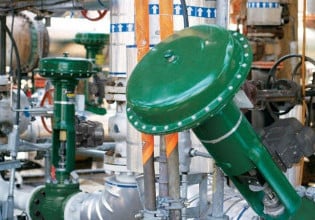In critical facilities, uptime is essential. When main power becomes interrupted, these applications depend on backup systems to ensure crucial equipment remains up and running. Not all mission-critical facilities are the same, though, and neither are their backup power needs. Adding to its extensive set of offerings, today, GE unveiled a new series of flywheel uninterruptible power supply (UPS) systems. The new flywheel UPS systems range from 50- to 1,000-kVA and integrate patented flywheel technology from VYCON, a subsidiary of Calnetix Technologies, with GE's TLE Series and SG Series solutions. Adding flywheel UPS systems to GE's range of backup power offerings provides flexibility to meet the needs of mission-critical customers.
In the event of a utility power outage, a UPS keeps electricity flowing to vital systems and equipment until auxiliary generators cycle on. There are two types of UPS systems primarily used by mission-critical customers today — battery and flywheel UPS systems. A battery UPS system stores energy and converts it to electricity through a chemical reaction. This solution can provide backup power for several minutes or hours, depending on the system, until an auxiliary source of power is switched on. A flywheel UPS system stores kinetic energy in the form of a spinning disk and is designed for short-time discharge applications.
“There are several advantages to using a flywheel UPS system in certain mission-critical applications,†explained Ray Prince, global product manager for UPS Solutions, GE Energy Connections’ Industrial Solutions. “By utilizing a flywheel UPS, customers can avoid costs associated with storing and replacing batteries. Additionally, a flywheel UPS system takes up less space in the power room and can reduce a facility’s overall carbon footprint.â€
Noteworthy benefits that GE’s flywheel UPS system offers customers include: Reduced Total Cost of Ownership: In contrast to battery-based UPS systems, flywheel-based systems have greater reliability, longer service life, a smaller footprint and no hazmat issues.
Simple and Reduced Maintenance: The VYCON flywheel incorporates a high-speed motor generator and five-axis active permanent magnetic bearings to levitate and sustain the rotor. The fully sealed, frictionless bearings require no lubrication and little to no maintenance. Additionally, GE’s flywheel UPS can be operated in extreme temperatures without degrading performance.
Improved Carbon Footprint: Flywheels provide a 96 percent reduction in embedded carbon emissions compared to lead-acid batteries, based on a typical 1-megawatt requirement and a 15-year operating period. This is equal to approximately 65,000 kilograms of embedded carbon.
System Flexibility: Up to six flywheel UPS modules can be installed in parallel to deliver greater power capacity, longer runtimes or redundancy. The flywheel UPS also can be integrated with batteries — with the flywheel providing the first line of defense for short-duration outages.
Real-Time Monitoring: GE’s iUPSGuard cloud-based remote monitoring solution provides UPS and flywheel status monitoring and alarm notifications. iUPSGuard notifies personnel of critical alarms and events via email or text message, allowing a user or GE technician to make timely decisions and repairs.
“Our flywheel energy storage technology is field proven,†said Frank DeLattre, president of VYCON. “We have deployed more than 1,200 of these systems worldwide with a total of over 16 million discharge cycles.â€






